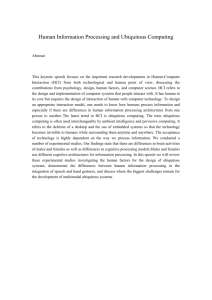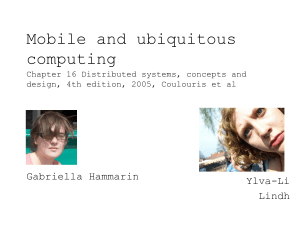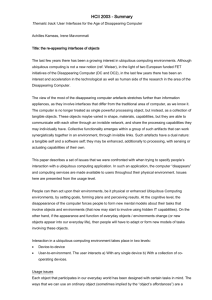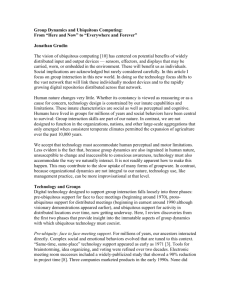Ubiquitous Computing
advertisement
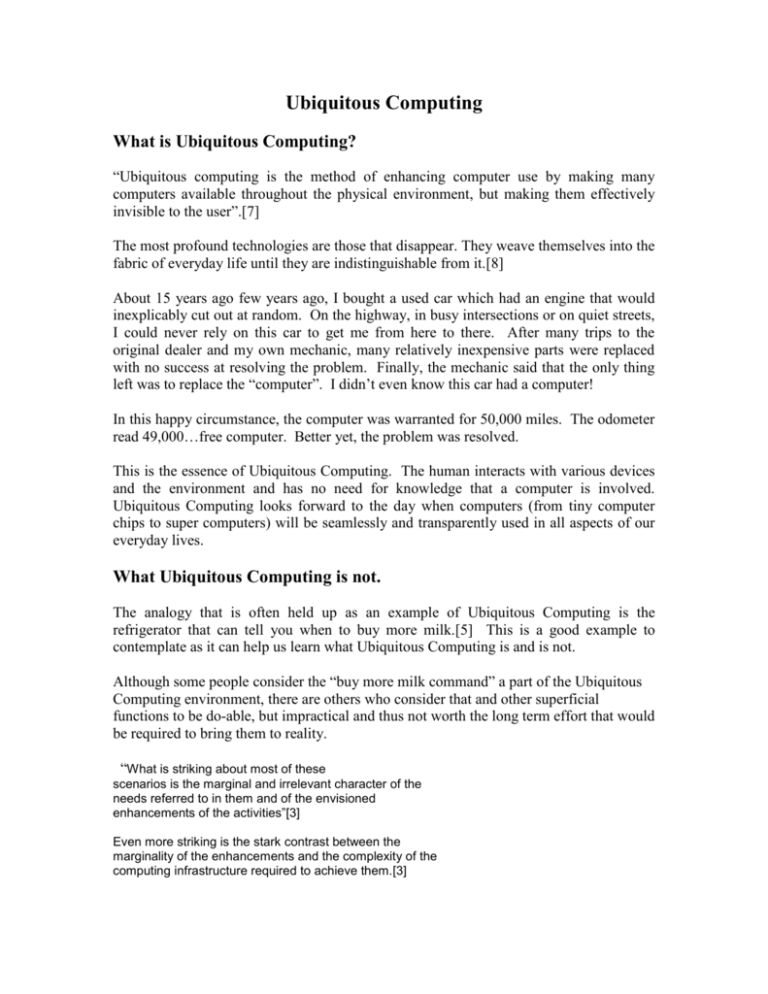
Ubiquitous Computing What is Ubiquitous Computing? “Ubiquitous computing is the method of enhancing computer use by making many computers available throughout the physical environment, but making them effectively invisible to the user”.[7] The most profound technologies are those that disappear. They weave themselves into the fabric of everyday life until they are indistinguishable from it.[8] About 15 years ago few years ago, I bought a used car which had an engine that would inexplicably cut out at random. On the highway, in busy intersections or on quiet streets, I could never rely on this car to get me from here to there. After many trips to the original dealer and my own mechanic, many relatively inexpensive parts were replaced with no success at resolving the problem. Finally, the mechanic said that the only thing left was to replace the “computer”. I didn’t even know this car had a computer! In this happy circumstance, the computer was warranted for 50,000 miles. The odometer read 49,000…free computer. Better yet, the problem was resolved. This is the essence of Ubiquitous Computing. The human interacts with various devices and the environment and has no need for knowledge that a computer is involved. Ubiquitous Computing looks forward to the day when computers (from tiny computer chips to super computers) will be seamlessly and transparently used in all aspects of our everyday lives. What Ubiquitous Computing is not. The analogy that is often held up as an example of Ubiquitous Computing is the refrigerator that can tell you when to buy more milk.[5] This is a good example to contemplate as it can help us learn what Ubiquitous Computing is and is not. Although some people consider the “buy more milk command” a part of the Ubiquitous Computing environment, there are others who consider that and other superficial functions to be do-able, but impractical and thus not worth the long term effort that would be required to bring them to reality. “What is striking about most of these scenarios is the marginal and irrelevant character of the needs referred to in them and of the envisioned enhancements of the activities”[3] Even more striking is the stark contrast between the marginality of the enhancements and the complexity of the computing infrastructure required to achieve them.[3] Knowing when to buy milk is a personal decision, involving not only how much milk is left, but also what your future plans are. Are you going to be out of town for the next few days? Are you going to have friends over for coffee… or cocoa? Ubiquitous Computing technology can be used to make simple decisions for us, but should it? “A few places in the world have begun work on a possible next generation computing environment in which each person is continually interacting with hundreds of nearby wirelessly interconnected computers. The point is to achieve the most effective kind of technology, that which is essentially invisible to the user.”[7] So the goal of Ubiquitous Computing is not to use computers to do unimportant tasks (which may become a consequence of Ubiquitous Computing), but rather, to create a vast infrastructure of computers that will be available to serve humans needs. Requirements for Ubiquitous Computing Ubiquitous Computing has two basic requirements: - - Natural interfaces – “We desire natural interfaces that facilitate a richer variety of communications capabilities between humans and computation.”[1] Ubiquitous Computing technology requires computers to be able to input information from natural human activity. That is, a human shouldn’t have to explicitly enter data into a computer. Humans communicate through speech, handwriting, gestures. Research is being conducted on how to translate that human communication into computer usable data. Context-awareness – “Ubicomp applications need to be context-aware, adapting their behavior based on information sensed from the physical and computational environment.[1] That is, in addition to recognizing Natural Interfaces from human activity, computer devices can become aware of elements in the environment, including other computing devices. The Pharmaceutical industry is currently testing the imbedding of computer chips in the boxes of product (Radio Frequency Identification – RFID Technology). These chips can be queried by other devices as they move from manufacturer to retailer, so that each box of product can be traced.[5] Thus the concept of Ubiquitous Computing doesn’t mean just that there are lots of computers in the environment, they also must collect data by monitoring natural human activity and be able to interact with other computing devices. Data Capture Problems Researchers are currently studying new materials and devices for data capture. Although Ubiquitous Computing requires seamless interfaces, it does not preclude the use of new materials and devices for data capture. Electronic Whiteboards, audio and video devices, pens and tablets, new types of ink and other devices are being developed and tested. [4][3][8] Use of these devices is not invisible to the user; but as they become more familiar, they will be more acceptable to Ubiquitous Computing technology. We are familiar with basic programming support for keyboard and mouse operations, Researchers are also working on basic programming support for audio, video and pens to parse and interpret that information. [3][5] Capturing human activity in a way that allows a computer to manipulate that data, is often very difficult. Handwriting is one example. Electronically capturing the hand movement is relatively easy using special pens, inks and tablets. But interpreting and manipulating those strokes as words and numbers or other symbols is much more difficult. Location awareness is an important aspect of Ubiquitous Computing. The most well known example is the Global Position System (GPS) device that can report where it is anywhere in the world. But there has also been research into Active Badges [8] and other location aware devices. It is important to note that no location-aware devices work everywhere, thus, a “handoff’ of information from one device to another will be required in some cases. “There is more to context than position and identity. Most context-aware systems still do not incorporate knowledge about time, history(recent or long past), other people than the user, as well a many other pieces of information often available in our environment”[1] Current systems focus their attention on one person. In a Ubiquitous Computing environment computers will have to incorporate the relationship of many people.[1] Generally, current systems are not aware of the passage of time (except for effective dated records). A baseline of behavior over time is of particular interest in Ubiquitous Computing.[1] Sensing contextual information such as body temperature, heart rate and galvanic skin response will help understand why people act as they do.[1] Devices to transmit and capture this information will be useful in a Ubiquitous Computing environment. Other areas that need to be explored - Context Fusion – No single device works in all environments (GPS often doesn’t work indoors). Compatible devices must be developed to hand off information from one device to another to in order to maintain location awareness.[1] - - - Network Protocols “Ubicomp changes the emphasis in networking in at least four areas: wireless media access, wide bandwidth, real-time capabilities for multimedia over standard networks, and packet routing.[7] Audio/video recording is easy, but systems to quickly retrieve specific information still need to be developed. For example audio recordings of the construction of a building could aid in maintenance.[1] Also with current technology recording “everything” isn’t an option. Decisions currently need to be made as to what information will be relevant in the future. As audio/video recordings move from the personal to recording public settings, privacy issues will have to be explored. Merging of multiple forms of media will add value to the Ubiquitous Computing environment. One function that could be considered close to Ubiquitous Computing is eMail. You can go to any computer workstation (that is connected to the Internet) and get your email regardless of who your eMail service provider is. Many people can go to any one of many display terminals and get eMail from one of many providers. The next step that would make it truly Ubiquitous Computing is that each person would have to carry or ware or have imbedded some sort of identifying device that would either contain or point to the person’s eMail provider, username and password. This is a big stumbling block. How much personal information do we want to be broadcast over the internet? This is one of the conundrums for Ubiquitous Computing. Pure Ubiquitous Computing requires that computers be able to recognize individual people without any need for the person to specifically communicate with the computer. On the other hand, we don’t want to have our personal information available for anyone (any computer) to pick up Study to decide how to provide maximum usable information for a Ubiquitous Computing environment, without providing personal information that can be connected to a specific person, will have to be conducted. Also how can we secure personal identification devices? Capture-and-access research There has been considerable research in the area of meeting-room/classroom environments: - Schmandt and Arons, 1985 and Hindus and Schmandt, 1992 recorded phone conversations and test ways to access the content. - The Tivoli System (Minneman et.al, 1995) used various software tools for recording note taking. - Electronic Whiteboard technology (Elrod et al, 1992) - Classroom 2000 (Abdowd, 1999) merged audio and video and ink media to access and displays the recordings in a synchronized fashion. - Experiments with support of capture of brainstorming sessions (Brotherton et al. 1999) and structured design meetings (Richter et al. 1999) Author’s Conclusion By its nature, Ubiquitous Computing is always a many-to-many relationship, many computers, many people and objects. Thus it can be extrapolated that in a truly Ubiquitous environment, Standards must come first. That’s not to say that proprietary work isn’t a necessary prerequisite to the standards, but a function can’t become Ubiquitous until the standards are in place. This has profound implications as to how the Ubiquitous Computing environment will be built. How do we reimburse an organization for their investment in developing a Ubiquitous Computing feature when the specifications have to be distributed to other manufactures after the standards are set? A great deal of thought will have to be invested in the question of personal information security. Truly Ubiquitous Computing requires that a significant amount of personal information be freely available for computers to pick-up and process. How to draw the line between necessary information and unnecessary private information will be a difficult problem. In the classroom there has been some research into video recording of classroom lectures and creating indexes so that a student reviewing the recording can quickly find a specific portion of the lecture. In addition there has been research into electronic whiteboard, pen and tablet forms of data capture. Before this feature can be truly ubiquitous the technology of video storage will have to be advanced so that the cost of storing all lectures will be considered trivial. The technology of creating indexes is secondary in importance. If good classroom videos are ubiquitous then electronic whiteboards and electronic tablets would be unnecessary. Bibliography [1]Abowd, Gregory D. and Mynatt, Elizabeth D. “Charting Past, Present, and Future Research in Ubiquitous Computing”, ACM Transactions on Computer-Human Interaction, Vol 7, No 1, March 2000, PP28-58 [2] Agu,Emmanuel , “CS 525M Mobile and Ubiquitous Computing Seminar” http://www.cs.wpi.edu/~emmanuel/courses/mobile_computing/slides/mc_intro_01_20.pd f [3] Araya, Agustin A., “Questioning Ubiquitous Computing”, Proceedings of the 1995 ACM 23rd Annual Conference on Computer Science, PP230 – 237, Nashville, TN, 1995 Also at http://delivery.acm.org/10.1145/260000/259560/p230araya.pdf?key1=259560&key2=1577869801&coll=portal&dl=ACM&CFID=11111111& CFTOKEN=2222222 [4] Dourish, Paul, “What we talk about when we talk about context”, Personal and Ubiquitous Computing, vol 8, Issue 1,February, 2004 Also at http://delivery.acm.org/10.1145/980000/970985/40080019.pdf?key1=970985&key2=414 7869801&coll=portal&dl=ACM&CFID=11111111&CFTOKEN=2222222 [5] Forcinio, Hallie , “What can Radio Frequency Identification Do for Pharmaceutical Packaging?”, Pharmaceutical Technology, Vol 27, No. 5, May, 2003 also at http://www.trenstar.com/pdfs/may_03_pharm_tech.pdf [6] Rhodes, Bradley J., Minar, Nelson and Weaver, Josh,”Wearable Computing Meets Ubiquitous Computing” The Proceedings of The Third International Symposium on Wearable Computers (ISWC '99), San Francisco, CA, October 18-19 1999, pp. 141-149. also at: http://xenia.media.mit.edu/~rhodes/Papers/wearhive.html [7]Weiser, Mark, “Some computer science issues in Ubiquitous Computing”, March 23, 1993, http://www.ubiq.com/hypertext//weiser,/UbiCACM.html [8] Weiser, M. (1991) The Computer for the Twenty-First Century. Scientific American, 265 (3), 94- 104. also at http://www.ubiq.com/hypertext/weiser/SciAmDraft3.html

